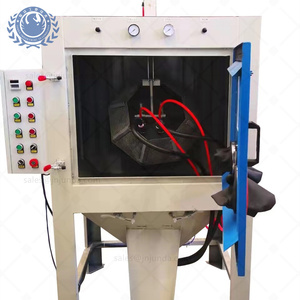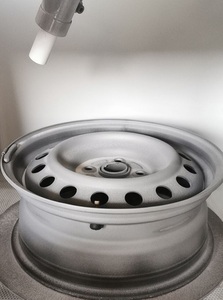
All categories
Featured selections
Trade Assurance
Buyer Central
Help Center
Get the app
Become a supplier

(1663 products available)




















A wet blasting cabinet is an industrial- or large-scale machine used to clean and prepare workpieces such as metal parts and components for painting, coating, or better adhesion. The wet blasting cabinet differs from the dry cabinet option in that a liquid (typically water) is used in the blasting process, which is known to reduce the amount of dust in the air.
While all wet blasting cabinets serve the same purpose of preparing workpieces for better paint or coating adherence, different kinds exist that may have some features and combinations of others:
The specification of a wet-blasting cabinet varies depending on the specific type and model. The following are the typical specifications of this equipment.
Proper cleaning and upkeep of the wet-blasting cabinet is critical to ensuring its effective operation and longevity. Here are some suggestions for maintenance of the cabinet:
A wet blasting cabinet is ideal for the following industries:
Automotive Industry
Wet blast cabinets are great for restoring engine parts, manifolds, carburetors, valve covers, wheel alloys, brackets, and suspension components.
Restoration Projects
Restoration projects to consider a wet blasting cabinet are vintage cars, motorcycles, bicycles, and tractors. It is perfect for restoring the original finish and elegant details of these classic collectibles.
Medical Equipment
This cabinet is great for restoring surgical equipment, diagnostic machines, therapeutic devices, orthopedic instruments, and dental equipment. It can help eliminate microorganisms, improve adhesion, and enhance the surface area of medical devices.
Aerospace Components
Aerospace manufacturers use wet blasting cabinets to prepare parts like turbine blades, airframes, landing gear, rocket nozzles, and aircraft engines. The wet cabinet improves finish quality and increases precision control. All this while lowering the risk of overheating.
Electronics
The wet blasting cabinet helps decontaminate and clean electronic device enclosures. It is also helpful for enhancing surface bonding for solder joints and cleaning circuit boards. This is crucial for improving electronic device performance.
Semiconductor Manufacturing
Wet blasting is a preferred method for cleaning and texturing substrates used in the production of semiconductors. It is ideal for silicon wafers, gallium arsenide, sapphire wafers, and substrates used in LED and MEMS (Microelectromechanical Systems) devices.
Optics Restoration
This cabinet can be used to restore and refurbish optical elements like lenses. These include rifle scopes, glasses, and binocular lenses. It is also helpful for cleaning the lens housings and optical tables.
Jewelry and Decorative Objects
Wet blast cabinets have a use in the jewelry industry. Goldsmiths use them to achieve a satin or matte finish in jewelry products like rings, earrings, bracelets, and pendants. The cabinets are also helpful in surface preparation and cleaning antique decorative objects made of metal.
Requirement analysis:
Buyers should begin by analyzing their particular requirements, including the types of components or materials to be blasted, the desired level of surface finish, and any specific constraints or requirements, such as noise reduction or waste management. This will help in selecting a cabinet that can handle their specific applications.
Blasting medium compatibility:
It is important to consider the compatibility of the blasting medium with the wet blasting cabinet. Some cabinets are only suitable for certain types of blasting media, such as glass beads, aluminum oxide, or soda blast, among others. Ensure that the selected cabinet can work with the chosen blasting medium for optimal results.
Cabinet size and construction:
Buyers should choose a cabinet that is the right size for their needs, considering the dimensions of the parts to be blasted and the available floor space in the facility. The cabinet should be constructed of durable materials, such as heavy-gauge steel or stainless steel, to withstand the abrasive action of the blasting media and the moist environment created during blasting.
Dust collection system:
A good wet blasting cabinet will include an effective dust collection system that prevents the escape of harmful dust particles into the surrounding environment. This may include a high-efficiency particulate air (HEPA) filter, a cyclonic separator, or a central vacuum system, among other elements. Buyers need to ensure that the cabinet's dust collection system complies with local air quality regulations and safety standards.
Q1: Is it possible to wet blast with regular compressed air?
A1: Yes, it is possible but not recommendable. Compressed air can be used in a wet blast cabinet if there is no other option. However, the process will be slower, and the air compressor may get overwhelmed and wear out from being dry fed.
Q2: What are five different types of wet blasting cabinets?
A2: The five most popular types of wet blasting cabinets are bead wet blasting cabinets, pipe wet blasting cabinets, ultrasonic wet blasting cabinets, vortex wet blasting cabinets, and pressure wet blasting cabinets.
Q3: What is the difference between a wet and a dry blasting cabinet?
A3: The primary difference between a wet and a dry blasting cabinet is that a wet blasting cabinet uses water or other liquid as a medium for blasting, while a dry blasting cabinet uses compressed air to propel abrasive materials onto the surface of the target item.
Q4: What are the parts of a wet blasting cabinet?
A4: The typical wet blasting cabinet parts include the cabinet body, blasting nozzle, abrasive media, air compressor hookup, dust extraction system, lighting, gloves, control panel, and sump pump.